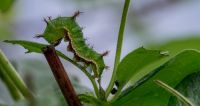Hitting back at Japanese Honeysuckle – Hundreds of Japan’s white admiral butterflies are emerging in New Zealand for the first time
Manaaki Whenua scientists have reached a milestone in the fight against an aggressive vine invading New Zealand native bush, roadsides, and wastelands.
Biocontrol scientists Hugh Gourlay and Quentin Paynter have successfully reared hundreds of Japan’s Honshu white admiral butterflies (Limenitis glorifica), a biocontrol agent for the widespread vine known as Japanese honeysuckle (Lonicera japonica), for the first time in New Zealand.
“It is a very significant step for us,” says Gourlay.
“Japanese honeysuckle is a really big problem. We’ve got several regional councils who have a problem with it and are keen to get hold of our biocontrol agents.”
Biocontrol is an extremely cost-effective, environmentally friendly, and permanent solution to controlling weeds.
Biocontrol agents are mainly insects that have been carefully selected and tested not to harm other plants or the environment. Once established, the agents don’t need any human input. They travel wherever the weed spreads and return to kill off new weed growth.
Japanese honeysuckle was first introduced as an ornamental hedging plant from Japan in 1872, but by 1926 it was reported to have started spreading and growing in the wild.
The flowering evergreen vine is a common sight across the country as the tough resilient plant spreads quickly, climbing over and suffocating plants.
In 2013, scientists were approved by the EPA to release the butterflies in New Zealand, and a year later, they attempted to use the Japanese butterfly’s caterpillars as a bio-control method for the weed – releasing a small number at Karangahake Gorge in the Waikato.
From there, they began successfully rearing the butterflies in shade houses at Manaaki Whenua’s Auckland and Lincoln sites.
“The rearing has been very successful. It’s the first time we have had vast numbers of caterpillars consuming our plants,” Gourlay says.
Butterflies are often fussy when it comes to the conditions in which they will mate. Quentin Paynter says they spent years trying to get them to mate in containment facilities.
“We tried for three years to mate the butterflies by hand pairing them, then tried to get the butterflies to mate and lay eggs by releasing them into the Butterfly Creek butterfly house near Auckland Airport and that didn’t work either.”
“So eventually we imported mated adult butterflies collected from the field in Japan, reared their laid eggs through to the adult stage and then trial released them in New Zealand. They became established at the first attempt and were then collected from the release site where we were delighted to find that their offspring displayed normal mating behavior in our shade houses, enabling mass-rearing,” says Paynter.
The reared butterflies are now laying thousands of yellow eggs, which will be released as an army of caterpillars at nine infested sites in the North and South Island.
“When we release the caterpillar stage we need to release large numbers of them at each site to try and ensure that we get establishment of them so we are aiming to release at least a thousand caterpillars at each release site around the country side,” Gourlay says.
The team will continue breeding the butterflies, and expect it will take around five to ten years to see a wide scale impact.
“It’s also a very long-term process. You can’t expect the weed to rapidly disappear because that rarely happens, especially for a weed like honeysuckle. It is about controlling the weed, reducing its presence in our environment. That’s the aim and those things often take quite a while to achieve,” says Gourlay.
Development of biocontrol for Japanese honeysuckle is funded by the National Biocontrol Collective.
All Manaaki Whenua – Landcare Research biocontrol agents have been thoroughly tested and approved by the EPA, DOC, MPI, and other professionals before biocontrol agents are released.

Japan’s Honshu white admiral butterflies (Limenitis glorifica)

White Admiral Caterpillar

Butterfly Chrysalis

White Admiral Butterfly

White Admiral Butterfly

White Admiral Butterfly

White Admiral Caterpillar

White Admiral Eggs

Butterfly Chrysalis
